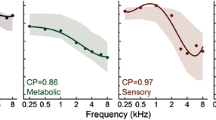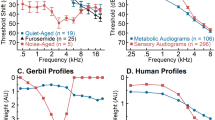Abstract
Age-related hearing loss (presbyacusis) has a complex etiology. Results from animal models detailing the effects of specific cochlear injuries on audiometric profiles may be used to understand the mechanisms underlying hearing loss in older humans and predict cochlear pathologies associated with certain audiometric configurations (“audiometric phenotypes”). Patterns of hearing loss associated with cochlear pathology in animal models were used to define schematic boundaries of human audiograms. Pathologies included evidence for metabolic, sensory, and a mixed metabolic + sensory phenotype; an older normal phenotype without threshold elevation was also defined. Audiograms from a large sample of older adults were then searched by a human expert for “exemplars” (best examples) of these phenotypes, without knowledge of the human subject demographic information. Mean thresholds and slopes of higher frequency thresholds of the audiograms assigned to the four phenotypes were consistent with the predefined schematic boundaries and differed significantly from each other. Significant differences in age, gender, and noise exposure history provided external validity for the four phenotypes. Three supervised machine learning classifiers were then used to assess reliability of the exemplar training set to estimate the probability that newly obtained audiograms exhibited one of the four phenotypes. These procedures classified the exemplars with a high degree of accuracy; classifications of the remaining cases were consistent with the exemplars with respect to average thresholds and demographic information. These results suggest that animal models of age-related hearing loss can be used to predict human cochlear pathology by classifying audiograms into phenotypic classifications that reflect probable etiologies for hearing loss in older humans.








Similar content being viewed by others
References
Allen PD, Eddins DA (2010) Presbycusis phenotypes form a heterogeneous continuum when ordered by degree and configuration of hearing loss. Hear Res 264:10–20
American National Standards Institute (1969) Specification for audiometers. ANSI S3.6-1969, American National Standards Institute, New York
American National Standards Institute (1989) Specification for audiometers. ANSI S3.6-1989, American National Standards Institute, New York
American National Standards Institute (1996) Specification for audiometers. ANSI S3.6-1996, American National Standards Institute, New York
American National Standards Institute (2004) Specification for audiometers. ANSI S3.6-2004, American National Standards Institute, New York
American National Standards Institute (2010) Specification for audiometers. ANSI S3.6-2010, American National Standards Institute, New York
American Speech–Language–Hearing Association (2005) Guidelines for manual pure-tone threshold audiometry. American Speech–Language–Hearing Association, Rockville, MD
Breiman L (2001) Random forests. Mach Learn 45:5–32
Chang CC, Lin CJ (2001). LIBSVM: a library for support vector machines. Software available http://www.csie.ntu.edu.tw/∼cjlin/papers/libsvm
Ciletti L, Flamme GA (2008) Prevalence of hearing impairment by gender and audiometric configuration: results from the National Health and Nutrition Examination Survey (1999–2004) and The Keokuk County Rural Health Study (1994–1998). J Am Acad Audiol 19:672–685
Cooper N, Rhode W (1997) Mechanical responses to two-tone distortion products in the apical and basal turns of the mammalian cochlea. J Neurophysiol 78:261–270
Crowe SJ, Guild SR, Polvogt LM (1934) Observations on the pathology of high tone deafness. Bull Johns Hopkins Hosp 54:315–379
Dallos P, Harris D (1978) Properties of auditory nerve responses in absence of outer hair cells. J Neurophysiol 41:365–383
Davis H (1983) An active process in cochlear mechanics. Hear Res 9:79–90
Dayal VS, Bhattacharyya TK (1986) Comparative study of age-related cochlear hair cell loss. Ann Otol Rhinol Laryngol 95:510–513
Dubno JR, Lee FS, Klein AJ, Matthews LJ, Lam CF (1995) Confidence limits for maximum word-recognition scores. J Speech Hear Res 38:490–502
Dubno JR, Lee FS, Matthews LJ, Mills JH (1997) Age-related and gender-related changes in monaural speech recognition. J Speech Lang Hear Res 40:444–452
Dubno JR, Lee FS, Matthews LJ, Ahlstrom JB, Horwitz AR, Mills JH (2008) Longitudinal changes in speech recognition in older persons. J Acoust Soc Am 123:462–475
Folstein MF, Folstein SE, McHugh PR (1975) Mini-mental state. A practical method for grading the cognitive state of patients for the clinician. J Psychiatr Res 12:189–198
Gates GA, Cobb JL, D'Agostino RB, Wolf PA (1993) The relation of hearing in the elderly to the presence of cardiovascular disease and cardiovascular risk factors. Arch Otolaryngol Head Neck Surg 119:156–161
Glorig A, Nixon J (1962) Hearing loss as a function of age. Laryngoscope 72:1596–1610
Gratton MA, Smythe BJ, Lam CF, Boettcher FA, Schmiedt RA (1997) Decline in the endocochlear potential corresponds to decreased Na,K-ATPase activity in the lateral wall of quiet-aged gerbils. Hear Res 108:9–16
Gruber J, Schaffer S, Halliwell B (2008) The mitochondrial free radical theory of ageing—where do we stand? Front Biosci 13:6554–6579
Hall M, Frank E, Holmes G, Pfahringer B, Reutemann P, Witten IH (2009) The WEKA Data Mining Software: an update. SIGKDD Explorations 11(1):10–18
Haller S, Lovblad KO, Giannakopoulos P (2011) Principles of classification analyses in mild cognitive impairment (MCI) and Alzheimer disease. J Alzheimers Dis 26(Suppl 3):389–394
Halpin C, Rauch SD (2009) Hearing aids and cochlear damage: the case against fitting the pure tone audiogram. Otolaryngol Head Neck Surg 140:629–632
Hellstrom LI, Schmiedt RA (1990) Compound action potential input/output functions in young and quiet-aged gerbils. Hear Res 50:163–174
Hellstrom LI, Schmiedt RA (1991) Rate-level functions of auditory-nerve fibers have similar slopes in young and old gerbils. Hear Res 53:217–221
Hellstrom LI, Schmiedt RA (1996) Measures of tuning and suppression in single-fiber and whole-nerve responses in young and quiet-aged gerbils. J Acoust Soc Am 100:3275–3285
Hinchcliffe R (1959) The threshold of hearing as a function of age. Acustica 9:303–308
Jerger J, Chmiel R, Stach B, Spretjnak M (1993) Gender affects audiometric shape in presbyacusis. J Am Acad Audiol 4:42–49
Kohavi R (1995) A study of cross-validation and bootstrap for accuracy estimation and model selection. In: Proceedings of the Fourteenth International Joint Conference on Artificial Intelligence San Francisco, CA: Morgan Kaufmann, pp 1137–1143
Kujawa SG, Liberman MC (2009) Adding insult to injury: cochlear nerve degeneration after "temporary" noise-induced hearing loss. J Neurosci 29:14077–14085
Lee FS, Matthews LJ, Mills JH, Dubno JR, Adkins WY (1998) Gender-specific effects of medicinal drugs on hearing levels of older persons. Otolaryngol Head Neck Surg 118:221–227
Lee FS, Matthews LJ, Dubno JR, Mills JH (2005) Longitudinal study of pure-tone thresholds in older persons. Ear Hear 26:1–11
Leske MC (1981) Prevalence estimates of communicative disorders in the US. ASHA 23:229–237
Liberman MC, Kiang NY (1978) Acoustic trauma in cats. Cochlear pathology and auditory-nerve activity. Acta Otolaryngol Suppl 358:1–63
Lin FR, Niparko JK, Luigi Ferrucci L (2011) Hearing loss prevalence in the United States. Arch Intern Med 171:1851–1853
Matthews LJ, Lee FS, Mills JH, Dubno JR (1997) Extended high-frequency thresholds in older adults. J Speech Lang Hear Res 40:208–214
Mills DM (2003) Differential responses to acoustic damage and furosemide in auditory brainstem and otoacoustic emission measures. J Acoust Soc Am 113:914–924
Mills DM (2006) Determining the cause of hearing loss: differential diagnosis using a comparison of audiometric and otoacoustic emission responses. Ear Hear 27:508–525
Mills DM, Schmiedt RA (2004) Metabolic presbycusis: differential changes in auditory brainstem and otoacoustic emission responses with chronic furosemide application in the gerbil. J Assoc Res Otolaryngol 5:1–10
Mills JH, Schmiedt RA, Kulish LF (1990) Age-related changes in auditory potentials of Mongolian gerbil. Hear Res 46:201–210
Mills JH, Lee FS, Dubno JR, Boettcher FA (1996) Interactions between age-related and noise-induced hearing loss. In: Axelsson A, Borchgrevink H, Hamernik R, Hellstrom P, Henderson D, Salvi R (eds) Scientific basis of noise-induced hearing loss. Thieme Medical, New York, pp 193–212
Mills JH, Schmiedt RA, Schulte BA, Dubno JR (2006) Age-related hearing loss: a loss of voltage, not hair cells. Semin Hear 27:228–236
Morrison DF (1976) Multivariate statistical methods, 2nd edn. McGraw-Hill, New York
Nadol JB (2010) Disorders of aging. In: Merchant SN, Nadol JB (eds) Schuknecht’s pathology of the ear, 3rd edn. PHPH-USA, Shelton CT, pp 431–475
Nelson E, Hinojosa R (2006) Presbycusis: a human temporal bone study of individuals with downward sloping audiometric patterns of hearing loss and review of the literature. Laryngoscope 116:1–12
Orrù G, Pettersson-Yeo W, Marquand AF, Sartori G, Mechelli A (2012) Using support vector machine to identify imaging biomarkers of neurological and psychiatric disease: a critical review. Neurosci Biobehav Rev 36:1140–1152
Robles L, Ruggero MA (2001) Mechanics of the mammalian cochlea. Physiol Rev 81:1305–1352
Ruggero MA, Rich NC (1991) Furosemide alters organ of corti mechanics: evidence for feedback of outer hair cells upon the basilar membrane. J Neurosci 11:1057–1067
Russell IJ (1983) Origin of the receptor potential in inner hair cells of the mammalian cochlea—evidence for Davis’ theory. Nature 301:334–336
Ryan A, Dallos P, McGee T (1979) Psychophysical turning curves and auditory thresholds after hair cell damage in the chinchilla. J Acoust Soc Am 66:370–378
Salt AN, Konishi T (1979) Effects of noise on cochlear potentials and endolymph potassium concentration recorded with potassium-selective electrodes. Hear Res 1:343–363
Schmiedt RA (1984) Acoustic injury and the physiology of hearing: a review and tutorial. J Acoust Soc Am 76:1293–1317
Schmiedt RA (1996) Effects of aging on potassium homeostasis and the endocochlear potential in the gerbil. Hear Res 102:125–132
Schmiedt RA (2010) The physiology of cochlear presbyacusis. In: Gordon-Salant S, Frisina RD, Popper AN, Fay RR (eds) The aging auditory system. Springer, New York, pp 9–38
Schmiedt RA, Mills JH, Adams JC (1990) Tuning and suppression in auditory nerve fibers of aged gerbils raised in quiet or noise. Hear Res 45:221–236
Schmiedt RA, Lang H, Okamura H, Schulte BA (2002) Effects of furosemide applied chronically to the round window: a model of metabolic presbycusis. J Neurosci 22:9643–9650
Schmiedt RA, Zwislocki JJ (1980) Effects of hair cell lesions on responses of cochlear nerve fibers. II. Single- and two-tone intensity functions in relation to tuning curves. J Neurophysiol 43:1390–1405
Schmiedt RA, Zwislocki JJ, Hamernik RP (1980) Effects of hair cell lesions on responses of cochlear nerve fibers. I. Lesions, tuning curves, two-tone inhibition, and responses to trapezoidal-wave patterns. J Neurophysiol 43:1367–1389
Schuknecht H (1964) Further observations on the pathology of presbycusis. Arch Otolaryngol 80:369–382
Schuknecht H (1974) Pathology of the ear. Harvard University Press, Cambridge
Schuknecht H, Gacek M (1993) Cochlear pathology in presbycusis. Ann Otol Rhinol Laryngol 102(Suppl 158):1–16
Schulte BA, Schmiedt RA (1992) Lateral wall Na, K-ATPase and endocochlear potentials decline with age in quiet-reared gerbils. Hear Res 61:35–46
Sewell WF (1984) The effects of furosemide on the endocochlear potential and auditory-nerve fiber tuning curves in cats. Hear Res 14:305–314
Sha S-H, Kanicki A, Dootz G, Talaska AE, Halsey K, Dolan D, Altschuler R, Schacht J (2008) Age-related auditory pathology in the CBA/J mouse. Hear Res 243:87–94
Suga F, Lindsay J (1976) Histopathological observations of presbyacusis. Ann Otol Rhinol Laryngol 85:169–184
Tarnowski B, Schmiedt RA, Hellstrom LI, Lee FA, Adams JC (1991) Age-related changes in cochleas of Mongolian gerbils. Hear Res 54:123–134
Touw WG, Bayjanov JR, Overmars L, Backus L, Boekhorst J, Wels M, van Hijum SA (2012) Data mining in the life sciences with random forest: a walk in the park or lost in the jungle? Brief Bioinform. doi:10.1093/bib/bbs034
Wilson RH (2011) Some observations on the nature of the audiometric 4000 Hz notch: data from 3430 veterans. J Am Acad Audiol 22:23–33
Wu R, Hoshino T (1999) Changes in off-lesion endocochlear potential following localized lesion in the lateral wall. Acta Otolaryngol 119:550–554
Yuen KC, McPherson B (2002) Audiometric configurations of hearing impaired children in Hong Kong: implications for amplification. Disabil Rehabil 24:904–913
Acknowledgments
This work was supported (in part) by grant P50 DC00422 from NIH/NIDCD, with a supplement from the American Recovery and Reinvestment Act. The project also received support from the South Carolina Clinical & Translational Research (SCTR) Institute, with an academic home at the Medical University of South Carolina, NIH/NCRR Grant number UL1 RR029882. This investigation was conducted in a facility constructed with support from Research Facilities Improvement Program Grant Number C06 RR14516 from the National Center for Research Resources, National Institutes of Health. Assistance by Jayne B. Ahlstrom, John H. Mills, and Bradley A. Schulte is gratefully acknowledged.
Author information
Authors and Affiliations
Corresponding author
Rights and permissions
About this article
Cite this article
Dubno, J.R., Eckert, M.A., Lee, FS. et al. Classifying Human Audiometric Phenotypes of Age-Related Hearing Loss from Animal Models. JARO 14, 687–701 (2013). https://doi.org/10.1007/s10162-013-0396-x
Received:
Accepted:
Published:
Issue Date:
DOI: https://doi.org/10.1007/s10162-013-0396-x




